 Conventional SSK attack submarines (Project 633, 1957)
Conventional SSK attack submarines (Project 633, 1957)
21 submarines (1958-62)
Soviet Cold War Subs
Pr.613 Whiskey | Pr.611 Zulu | Pr.615 Quebec | Pr.633 Romeo | Pr.651 Juliet | Pr.641 Foxtrot | Pr.641 buki Tango | Pr.877 KiloPr.627 kit November | Pr.659 Echo I | Pr.675 Echo II | Pr.671 Victor I | Pr.671RT Victor II | Pr.671RTMK Victor III | Pr.670/670M skat Charlie | Pr.705 lira Alfa | Pr.949 antey Oscar | Pr.945 barrakuda Sierra | Pr.971 bars Akula | Pr.885 graney Yasen | Pr. 545 Laika
Pr.629 Golf | Pr.658 Hotel | Pr.667A Yankee | Pr.667B Murena Delta I | Pr.667D Delta II | Pr.667BDR Kalmar Delta III | Pr.667 BDMR delfin Delta IV | Pr. 941 akula Typhoon | Pr.995 borei Dolgorukiy | Pr.09851 Khabarovsk
Introduction:
Perhaps not the best-known cold war conventional submarine of Soviet naval forces, the Romeo class as known in the Western world were the Project 633. They were nevertheless known for two reasons:
-First, they took the succession of the Project 613 (Whiskey class), the 1st generation cold war soviet submarines.
-Second, and that’s an irony, more where produced by China than USSR (and exported), as the Type 033
-Third, together with the Zulu and Quebec classes (Project 611/615), they served as test-beds for the mass-produced cold war success SSK, the Foxtrot class (1963). All three models explored different pathways.
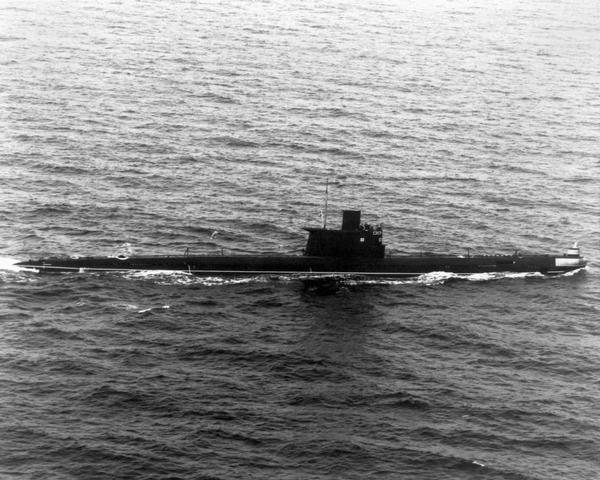
Development of Project 633
The Project 633 initial design requirements were emitted by TTZ in 1952-53. The direction these successors to Project 613 could take were not difficult to guess: Better performances, in range, speed, and diving depth. Since they were much larger, displacing as much as 1400 tonnes standard, versus 1050 tonnes for the Whiskey, the enlarged and redesigned hull could carry more diesel fuel, solving the range problem. Endurance was almost doubled as a result, while the larger bow could accommodate two more tubes, for eight total. This range was obtained however by reducing top speed, up to 15.5 knots versus 18.5 knots on Project 613, although underwater it was the same.
But there was a parallel project, 611 (NATO “Zulu” class) much larger, that was built from 1952, and the ‘Romeo’ took from it as well and were seen as an improved version. While the “Zulu” was just an enlarged “Whiskey” chiefly for range, it was better armed and even was equipped with deck guns. Its technology was much older, going back to a 1946 TTZ requirement. The Type 615 “Quebec” was the completely reverse proposal, a coastal submersible of 400 tonnes, the first built in 1954. So the Romeo was seen as the true successor of Project 611, and being the last of the three was also the most developed, immediate predecessor of the Foxtrot class.
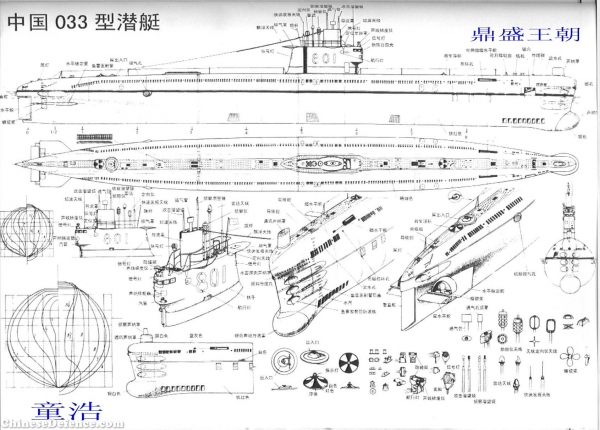
Chinese Type 033 Romeo, the main production run, making the latter one of the world’s most prolific cold war sub.
Project 633 began life as a 1954 TTZ final requirement for an advanced coastal submarine developed from Project 613 and exploiting the late WW2, the Kreislauf drive technology. The latter was developed for Project 615 (Quebec class). This version would have been fitted with Kreislauf diesels mated on both shaft but soon that technology appeared too immature for fleet use. Project 633 was then to be equipped with standard 37-D diesels. The Kreislauf drive was a system for a “conjoint control of vehicle sub-units of different type or different function including control of propulsion units including control of combustion engines” as defined in google patents (its now free tech). Basically it was a closed-circuit diesel engine using argon as cycle medium. More on CORDIS.
Design
Hull design
The hull of the 633 boats was 77.8 meter long overall for the outer shell, with a circa 60 meter long pressure hull, for about 5.3 meters in diameter at its widest at the main command bridge. Construction of it was so strong that it could withstand the pressure wave of a medium-sized atomic bomb at 1,600 meters, or possibly a small nuclear depth charge as developed by the Soviets later. The internal hull was divided into seven compartments and was a mixture of internal and external framing:
-Section 1: Torpedo tubes room (six) and associated storage, 13 bunks, plus steering gear for the forward depth rudder.
-section 2: Batteries, and commandant’s cabin, officers’ cabins, washroom, radio station and fresh water tank.
-section 3: Control center with instruments, sonar station, toilet, pump systems, access to the bridge kiosk above.
-section 4: 20 bunks, aft battery pack, washroom 2, various tanks.
-section 5: Main engine room, diesels and APU and controls for environmental systems, snorkel.
-section 6: Electric engine room, two cabins of three bunks.
-section 7: Stern torpedo tubes room, reserve torpedoes, rear hatch, four bunks, toilet 2, main steering gear.
The bridge tower was 5 meters high but not waterproof, entirely flooded when submerged to the exception of the lower front third of the tower, connected between the access door on deck, and the central section, and open weather bridge above. The latter bad weather bridge was at the front of the tower in an advanced overhanging position. It contained a compass, six windows. Behind were located two periscopes and a radar, all retractable into their own structure.
Powerplant & performances
Power and speed:
The machinery layout repeated Project 613 with a two-shaft system, each connected to a single diesel. The main propulsion unit therefore comprised both Soviet-built 37D marine diesel engines, each delivering an output of 2,000 hp (1,471 kW). They burnt fuel oil and oxygen from ambient air, supplied on surface from outside or in shallow water using the snorkel, providing a top speed of 15.2 knots, which was not stellar. All other sub types of the time were capable of 18 knots, but due to the added range it was found adequate, and the Foxtrot class were down to 16.6 knots. After diving, only water resistance acted as a brake to reduced this speed, and deeper as the snorkel was retracted, the two PG-101 electric motors entered in action. Producing 1,350 hp each, they allowed an underwater speed of 13 knots, which was in the norm.
Range: The greatest feature of the 633 design was its range, at 9 knots of cruising speed, of 14,600 nautical miles (16,000 for conway’s), but with the diesel engines alone, with an extra 14 nautical miles on the electric drives at 13 knots.
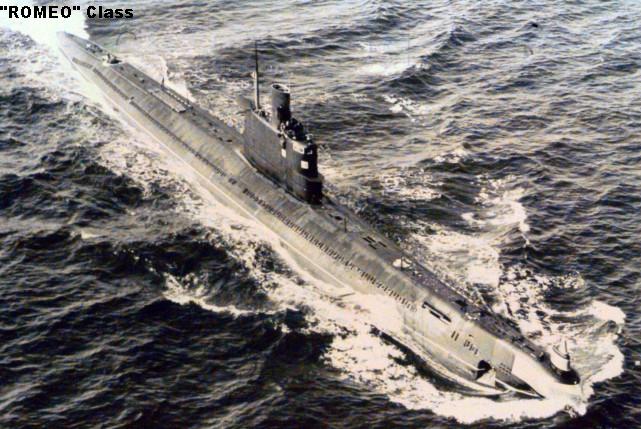
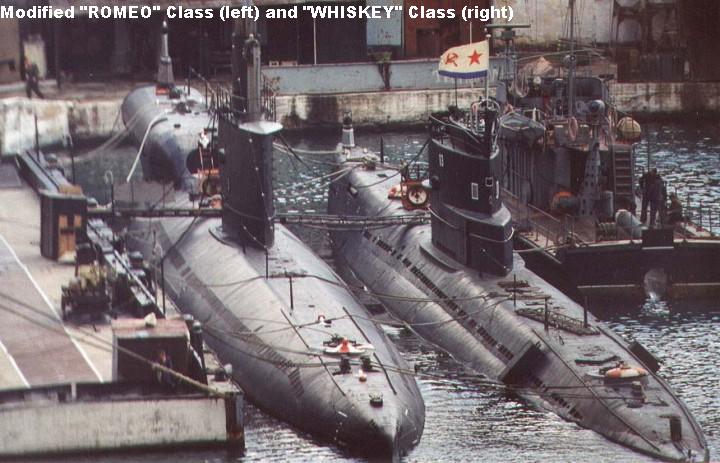
Sensors
The main sensor array of Project 633 was the Arktika-M sonar system (NATO “Pike Jaw”), used for target tracking. It was supplemented by the MG-15 passive sonar system. By this combination the Romeo could track targets under and above water. The submarine transmitters and receivers were mounted on the top, and bottom of the bow. There was also a retractable radar (NATO “Snoop Plate”) close to the periscopes and working in the X-band with 80 kW, for surface search.
The new sonar system was a considerable advance compared to Project 613, developed in parallel to the one fitted later on Project 641 (Foxtrot class). It offered a vastly improved target acquisition and localization. This was a long derivative of the WW2 German GHG/Balkon system, installed in a bulge under the bow. Called MG-10 Feniks-M was used for submarine detectionand above it was located the MG-200 Arktika-M. This was the active scanning sonar, with a small underwater telephone fitted on top. Targeting data was sent to the new Leningrad fire control system, a copy of the American wartime TDC system. This was the first soviet underwater dedicated fire control system ever fitted. It became the great standard for all soviet subs for almost twenty years. The sail on its side contained the sonar intercept system MG-23 Svet-M.

Simple profile
Armament
Project 633 used conventional torpedo tube, six mounted in the bow and two in the stern, all of the same type and caliber. This configuration furiously reminded the Second World War. These tubes launched the standard Soviet torpedo types of the time, all tested and approved. There was also an archaic WW2 feature maintained only for the first units of the class, a provision was made for a deck gun mounted forward of the bridge. In practice it was never mounted. This feature was also seen on Chinese-built Type 033, but again, the gun was absent.
The Pr. 633 boats carried the following torpedoes:
–ET-46/ET-56: Essentially modernized copies of the German G-7e torpedoes developed in the the 1950s.
–-53-39MP: An evolved version of the unguided 53-39, wartime standard, further developed and called an “area search torpedo”.
–-The 53-57: Also called by NATO 53-56, this was an unguided model of considerable top speed (51 knots at highest setting) which later was modified to carry a tactical nuclear warhead. According to Apalkow, it had built-in sensors making it a homing torpedo.
Project 633 could also carry and launch through the same tubes up to twelve PMR-1 and PMR-2 sea mines.

Missiles conversion projects:
The basic Project 633 tested missiles designs that were never produced:
-Project 633A: Born from 1955 TTZ spec. it was designed to fire the new P-15 Termit anti-ship missile. Four were to be carried in external cylinder launchers faired into the outer hull casing, before and aft of the sail. None was build but plans were transferred to China and the latter built one on a modified version of these plans, called Project 033G Wuhan.
Project 633B: This was a derivative to fire the P-5 Pityorka (NATO Shaddock) strategic cruise missile, with four carried in an enlarged semi-streamlined superstructure around the fin. Project 633B was cancelled along with the whole Project 633 but the concept was tested on the Project 665 Whiskey Longbin.
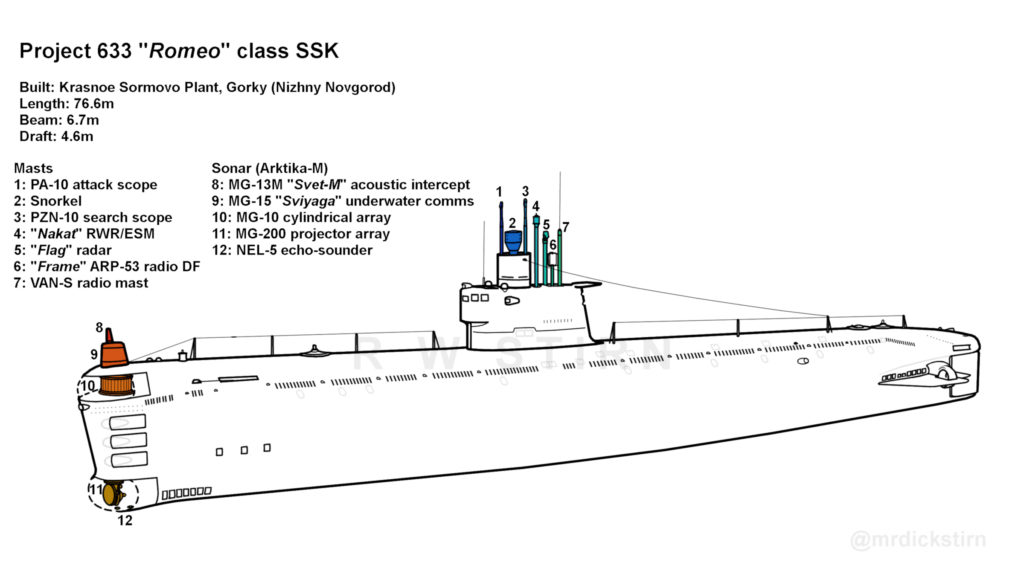
Diagram by Richard W. Stirn.
Production, modernizations & variants
In total, only 21 was produced in USSR according to hull numbers, but added to the Chinese ones, this is a total of 112 (96 Chinese, 16 North Korean), so more than the Foxtrot or any other sub type worldwide bu the 1950 “Whiskey”. However this was still nothing: The Soviet staff was very ambitious about this program signed by Stalin, which favoured mass-production: 560 submarines were indeed projected. However the programme was terminated in 1955 by Khrushchev. In accordance with Admiral Kuznetsov, the new direction of the Navy was not mass-construction for a conventional naval warfare as planned by Stalin, but trying to reach technological excellence to compensate for numbers.
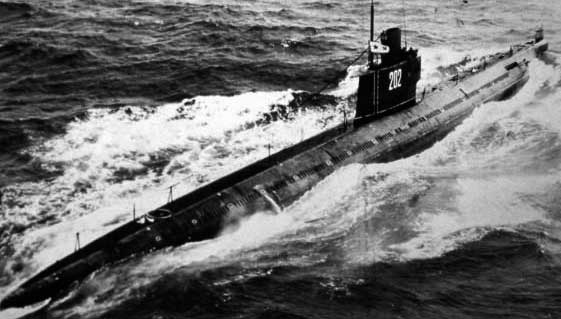
The soviet premier decided that all non-nuclear submarine construction would be terminated, which was not received well by a part of the Soviet Navy staff, believing SSNs would be too expensive and too long to develop. For the numbers required, only diesel-electrics could do, especially for shallow water and coastal patrols. Project 641 was saved by this navy staff action, but under condition that Project 633 would be merged with it as it was impossible to justify two types. In 1959, construction of any other boats of the 633 project was cancelled while tooling and blueprints were sent to China, quickly turned, with Soviet assistance in a naval yard dedicated to submarines into mass production. This became the Project 033.
Project 633L (1967):
S350 was taken in hands from 1967 to 1969 in Gorki, to test hull shapes at Krasnoe Sormovo, Gorky. The boat retained eight torpedoes onboard, no spares to make room.
Project 633RW (1971):
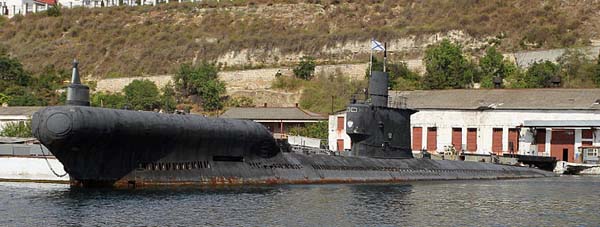
Project 633RW as preserved in 2012
This first conversion at Sevmorzavod and Sevastopol base “Krasnoe Sormovo” saw two massive 650 mm torpedo tubes mounted on S-11 and S-49 for tests. The special torpedoes were 11m long, so they were placed on the foredeck, in a new enclosed structure. Of course, no spare torpedoes could be transported for a reload. The launching structure was waterproof and built under the same pressure requirements as the main hull. The other advantage of the structure was to provide the capability to launch the RPK-7 (86R URPK-7 «Veter» anti-submarine guided missile), or RPK-11 missile or the heavy torpedo 65-76 or 65-73, nuclear-tipped. While two 533 mm tubes were converted to fire the anti-submarine guided missiles 83R URPK-6 «Vodopad». Displacement of the 633RW rose to 1,350 tons (surface) 1,810 tons (underwater) for 78 m overall. In addition, these were refitted with new PG-101M-1 electric motors, capable of a top speed of 15/12 kts, the crew was 58 officers and sailors, and the Sever-N-633RV navigation complex was installed. This conversion was made in parallel to Project 671RT, so between 1971 and 1972 (Victor II).
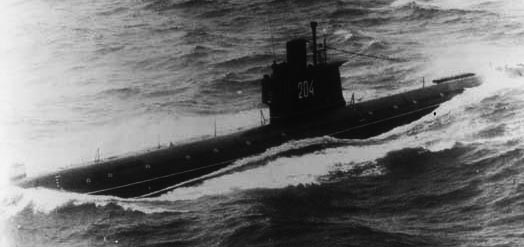
Project 633KS (1978):
S-128 was built in 1978 in the Sevmorzavod yard in Sevastopol, to test the 3K10 Granat missile system. It was fitted with two launchers (launching the 3M10 cruise missile). This model also had a floating battery recharging station PZS-50. A modernization of the type was planned (Project I633/Ts633) but never carried out.
Active service
The class entered service from 1958, mostly in the black sea fleet:
-Black Sea Fleet: S-32 (transferred in 1960 to the Northern Fleet), S-34 (same), S-36 (same 1961, 1981 back), S-37 (same 1965, 1982 back), S-38 (same 1969, 1980 Back), S-49 (same 1962, back 1969), S-53 (same 1961, 1980 Black Sea Fleet, 1985 Baltic Fleet), S-57 (same 1962, 1970 back), S-101 (same 1961, 1982 Baltic Fleet), S-128 (same 1961, 1977 back), S-212 (same 1961, 1970 back), S-350 (same 1959, 1966 back), S-351 (same 1960, 1966 Baltic Fleet), S-352 (same 1960, 1966 Baltic Fleet), S-353 (from 16.07.1960 Northern Fleet), 354 (from 18.07.1960 Northern Fleet)
-Northern Fleet: Only four: S-4 (1982 Black Sea Fleet), S-7, S-11 (1962 Black Sea Fleet, back 1963, 1972 Baltic Fleet, 1972 back then 1976 Black Sea Fleet), S-28 (1981 Baltic Fleet).

A Romeo class sub in 1986.
Reception of the Romeo by experts
Forecast International report stated that the class diesel engines exhibited poor quality and showed important torsional flexing on crankshafts, and due to loose tolerances in all mechanical components, there was an excessive wear of all moving parts, and massive oil leaks to the point some could be visible on the surface when at snorkel depth. Batteries also had quite serious quality control issues, never fully acquiring, keeping their 100% charge and had a very limited life in terms of cycles. They also are impacted by excessive gas generation, plate distortion under heavy consumption. This traduced into low operational readiness of the class as a whole. The Romeo class is defined as essentially a WW2 design. It is slow and noisy with average to poor sensors, so both easy to detect and unable to detect other subs in the area. The hull integrity is subjected to low quality control in general and the anti-ship capabilities are limited by the use of straight-running torpedoes, also derived from a WW2 design. In short, although there was considerable improvement over the Project 613 “Whiskey”, this was still a 1st generation cold war SSK. The fact the class was built almost without changes by the Chinese into the 1980s was not to their credit.
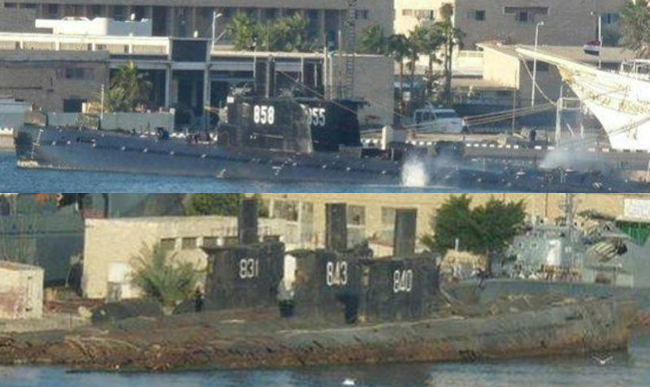
Egyptian Romeo Type 033 (Chinese version)
Exports
Algeria: 2 boats, 010 (1982) and 011 (1983), decommissioned in 1989.
Bulgaria: 4 boats, the Leninksi komsomol 81 (later Pobeda) (1972) decomm. 1990, Dimitrovski komsomol 41(82)/Viktoriya (1972) decomm. 1992, Nadezhda 83 (1985) decomm. 2008, Slava 84 (1983) decomm. 2011 a museum as of 2019 in Beloslavl.
Egypt: 6 boats, 196-67 Type 180: N°831, 834, 837, 840 (plus six ex-Chinese 1982-87).
China: 92: See the Type 033 post. First transferred, other licence-built.
Northern Korea: 25 total: 7 boats, ex-Chinese, called Type 13 (2 1973, 2 1974, 3 1975), 16 built under license 1975-82.
Syria: 3 boats transferred 1985, 86, 87: Mumbata S01, S-53, S-101.
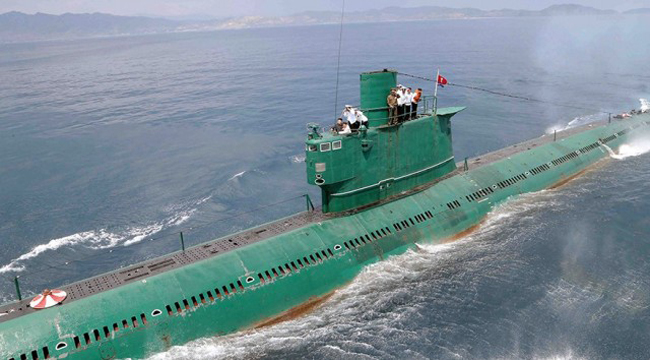
North Korean 033 submarine, built locally with Chinese assistance. These are still in service.
The Chinese Romeo
Under the 1950 Sino-Soviet Treaty of Friendship, Alliance and Mutual Assistance, documentation was passed to the PRC to produce Romeo class submarines in 1963. The first thirteen built under assistance as the first Chinese variant was known in NATO circle as the Romeo Type 033. However the type was “improved” and modified after the split of relations with USSR, and a total of 84 Type 033 submarines were delivered, the last in 1984, plus exports.
Type 031 The first twelve boats, faithful copies of Project 633, assembled with Soviet assistance, tooling and components. This Type 6633 saw only two of the disassembled kit boats made, the rest was modified already with domestic batteries, better than the Soviet ones.
Type 033: PLAN designation for the modified Project 633. Electronic equipments were modified, and the sonar updated (Type 105) and the SQ2-262A sonar by Factory No.613. Noise reduction was lowered to 20 dB. Also the air conditioning and refrigeration systems were adapted to Chinese conditions. The first 13 were built at Huangpu Shipyard in Guangzhou.
The type 033 ES5A had many enhancements, with the QZHA―10 (Type 779) and the QDYA-10 (Type 778) periscopes, H/SQG-2 (type 801) and H/SQZ-D sonars, Type 063 communication systems and ECM.
Later, the 033G appeared, modified to launch acoustic homing torpedoes. A single 033G1 prototype was tested to fire six YJ-1 anti-ship missiles (CSS-N-4).
The overall production lasted from 1962 to 1984, with 84 delivered, making the largest conventional SSK production worldwide outside USSR. Of course the type was totally obsolete and retired in the 2010s.
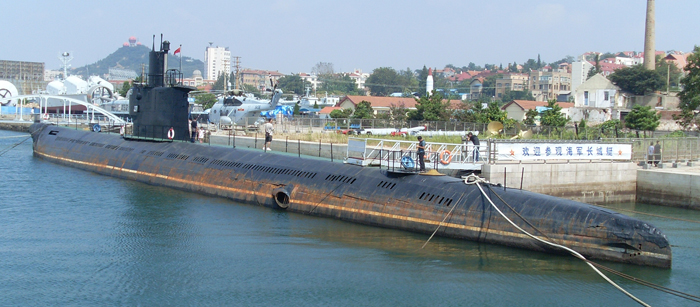
Chinese Type 033 underway

Romeo class, CC profile by mike1979russia
Specifications
Displacement: 1470-1830 tons Surface/dive (Conways 1300/1700)
Dimensions: 77 x 6,7 x 4,9 m
Propulsion: 2 shafts diesels 4,000 hp, 15.5/13 knots Surf/sub 270-300 m
Crew: 56
Armement: 8 x 533 mm (6 b, 2s, 14 torp/12 mines)
Electronics: Radar Snoop Plate, Sonar M/F Herkules, antenne passive Fenika, ECM Stop Light.
The North Korean Romeo-based SSBN
A “tactical nuclear ballistic missile”, has been launched recently. By September 6, 2023, the ship was unveiled via KCNA as a modified Romeo-class sub, christened under the name Kim Kun Ok.The submarine has a large missile compartment behind the sail with 10 vertical launch tubes laid out in two rows of five, with the front four being larger to house SLBMs like the Pukguksong-1/KN-11 and the remaining smaller six housing submarine-launched cruise missiles. A different South Korean report claims that North Korea is also developing a larger submarine, at around 4000 to 5000 tons. This particular weight would fit the category of a nuclear submarine, which had been a stated goal by Kim Jong-un at the 8th Congress of the Workers’ Party of Korea. See more on HI Sutton.
Read more
https://en.wikipedia.org/wiki/Romeo-class_submarine
http://russianships.info/eng/submarines/project_633.htm
https://www.hazegray.org/features/russia/ss.htm
https://www.navypedia.org/ships/russia/ru_ss_s4.htm
https://www.militaryfactory.com/ships/detail.asp?ship_id=romeo-class-diesel-electric-attack-submarine-soviet-union
About the North Korean variant Project 13
Kim Jong-un inspect his subs [archive], MSN news 16 june 2014
Kim Jong-un sur on a « Romeo » [archive], Strategic Bureau, 19 june 2014
(en) James C. Bussert, « Chinese Naval Sonar Evolves From Foreign Influences » AFCEA December 2002
Model Kits:
Modellist kit 1/144


 Latest Facebook Entry -
Latest Facebook Entry -  X(Tweeter) Naval Encyclopedia's deck archive
X(Tweeter) Naval Encyclopedia's deck archive Instagram (@navalencyc)
Instagram (@navalencyc)





 French Navy
French Navy Royal Navy
Royal Navy Russian Navy
Russian Navy Armada Espanola
Armada Espanola Austrian Navy
Austrian Navy K.u.K. Kriegsmarine
K.u.K. Kriegsmarine Dansk Marine
Dansk Marine Nautiko Hellenon
Nautiko Hellenon Koninklije Marine 1870
Koninklije Marine 1870 Marinha do Brasil
Marinha do Brasil Osmanlı Donanması
Osmanlı Donanması Marina Do Peru
Marina Do Peru Marinha do Portugal
Marinha do Portugal Regia Marina 1870
Regia Marina 1870 Nihhon Kaigun 1870
Nihhon Kaigun 1870 Preußische Marine 1870
Preußische Marine 1870 Russkiy Flot 1870
Russkiy Flot 1870 Svenska marinen
Svenska marinen Søværnet
Søværnet Union Navy
Union Navy Confederate Navy
Confederate Navy Armada de Argentina
Armada de Argentina Imperial Chinese Navy
Imperial Chinese Navy Marinha do Portugal
Marinha do Portugal Mexico
Mexico Kaiserliche Marine
Kaiserliche Marine 1898 US Navy
1898 US Navy Sovietskiy Flot
Sovietskiy Flot Royal Canadian Navy
Royal Canadian Navy Royal Australian Navy
Royal Australian Navy RNZN Fleet
RNZN Fleet Chinese Navy 1937
Chinese Navy 1937 Kriegsmarine
Kriegsmarine Chilean Navy
Chilean Navy Danish Navy
Danish Navy Finnish Navy
Finnish Navy Hellenic Navy
Hellenic Navy Polish Navy
Polish Navy Romanian Navy
Romanian Navy Turkish Navy
Turkish Navy Royal Yugoslav Navy
Royal Yugoslav Navy Royal Thai Navy
Royal Thai Navy Minor Navies
Minor Navies Albania
Albania Austria
Austria Belgium
Belgium Columbia
Columbia Costa Rica
Costa Rica Cuba
Cuba Czechoslovakia
Czechoslovakia Dominican Republic
Dominican Republic Haiti
Haiti Hungary
Hungary Honduras
Honduras Estonia
Estonia Iceland
Iceland Eire
Eire Equador
Equador Iran
Iran Iraq
Iraq Latvia
Latvia Liberia
Liberia Lithuania
Lithuania Mandchukuo
Mandchukuo Morocco
Morocco Nicaragua
Nicaragua Persia
Persia San Salvador
San Salvador Sarawak
Sarawak Uruguay
Uruguay Venezuela
Venezuela Zanzibar
Zanzibar Warsaw Pact Navies
Warsaw Pact Navies Bulgaria
Bulgaria Hungary
Hungary

 Bundesmarine
Bundesmarine Dutch Navy
Dutch Navy Hellenic Navy
Hellenic Navy Marina Militare
Marina Militare Yugoslav Navy
Yugoslav Navy Chinese Navy
Chinese Navy Indian Navy
Indian Navy Indonesian Navy
Indonesian Navy JMSDF
JMSDF North Korean Navy
North Korean Navy Pakistani Navy
Pakistani Navy Philippines Navy
Philippines Navy ROKN
ROKN Rep. of Singapore Navy
Rep. of Singapore Navy Taiwanese Navy
Taiwanese Navy IDF Navy
IDF Navy Saudi Navy
Saudi Navy Royal New Zealand Navy
Royal New Zealand Navy Egyptian Navy
Egyptian Navy South African Navy
South African Navy






























 Ukrainian Navy
Ukrainian Navy dbodesign
dbodesign